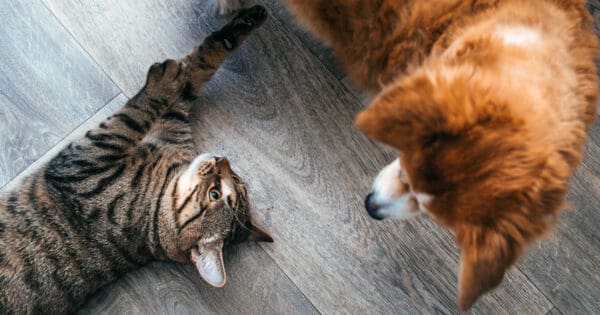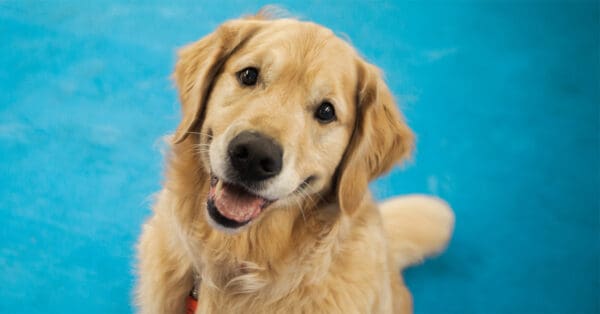
11401 NE 195th St. Bothell, WA 98011
(425) 486-9000 PHONE (425) 486-9002 fax
Notice: Below care sheet is from 2016, and may not reflect up-to-date care information.
Quick facts
- Leopard geckos (Eublepharis macularius) originated from the Middle East (Afghanistan, India, and Pakistan). They are ground dwelling, nocturnal, insectivorous lizards. Adults average lengths of 20-30 cm long and typically weigh 45-75 grams.
- Leopard geckos are one of the most popular and easiest geckos to keep as pets.
- A variety of different pattern or color variations, known as “morphs,” are available due to selective breeding.
- With proper care, a leopard gecko can easily live up to 20 years.
Enclosure
A 10 gallon glass aquarium tank is sufficient for a single adult or juvenile leopard gecko. Larger enclosures are required if more than one gecko is being housed together. A 20 gallon long glass aquarium tank can be used for a small colony (3-5 geckos) as long as there are adequate hides available. NEVER place two males in the same enclosure, as they will typically fight and severely injure each other.
In order for the gecko to feel secure in its enclosure, provide several hiding places. These can be as simple as inverted plant saucer pans, cardboard tubes/boxes, plants, wood, etc. Always have at least one hide per gecko on both the warm end and cool end (discussed in heat section below) of the cage. This will allow them to hide and feel comfortable on both ends of the cage.
A humid hide should also be provided to help allow your gecko to shed its skin properly. The most popular way of providing one of these hides is to make your own using a disposable plastic container such as Gladware. Cut a hole in the lid and fill the inside of the container with moist peat moss, sphagnum moss, forest bed (Coconut fiber), or paper towel.
Substrate
The safest and easiest substrates to use are paper, newspaper, paper towel, or slate. If you prefer a more naturalistic look, go with slate. “Reptile Carpet” can be used, but must be changed and washed (preferably in a washing machine with detergent) at least weekly. Aquarium gravel, walnut shells, calcium sand, and natural sand are not recommended, due to the risk of intestinal impactions if swallowed.
Heat & Light
It is very important to provide a temperature gradient for your leopard gecko to allow him/her to regulate its own body temperature. The warm end of the enclosure should be maintained at 88°-90°F, with the opposite side of the cage in the mid-70s° F. A basking spot in the mid- to upper 90s°F should also be provided. There are several different ways to provide proper heat. A common method is to use under-tank heating using a strip of heat tape run under the cage. A thermostat must be used to control the temperature of the heat tape if this method is used. Another option is to provide a basking lamp with a 60-100 watt Ceramic Heat Emitter bulb, which will give off heat without light. Both methods work very well for certain enclosures.
Either way, the enclosure temperature should be monitored closely with an accurate thermometer to make sure that it is staying in the “optimum temperature zone” for your pet. We recommend using temperature guns or probe thermometers so that the actual temperature of the cage floor or basking spot can be accurately measured. Dial or tape thermometers placed on the wall of the enclosure do not accurately reflect the temperatures your pet is experiencing.
Many people believe that because leopard geckos are nocturnal, there is no need to provide them with special UVB lighting. However, current research has shown that they do best with low-level UVB lighting. We recommend providing your gecko with 2.0 Reptile UV bulb lighting for 12 hours per day. Be sure to change the bulb every 4-6 months, as fluorescent bulbs stop producing UV light long before they stop producing visible light.
Diet
Leopard Geckos are insectivores. The most common items used as a staple diet are crickets, mealworms, superworms, silkworms, and small cockroaches. Ideally, a variety of these insects should be fed to help prevent dietary deficiencies and provide enrichment to your gecko. Many gecko owners will keep a colony of the base diet insects so that they can control the quality of the prey items they are offering to their pet.
Juvenile leopard geckos should eat once daily, while adults should be fed three times weekly. Feed as many insects as the gecko will consume within a sitting. Make sure that the insect prey is appropriately sized for your gecko. The insects should not be larger than the width of the gecko’s head.
We recommend feeding the insects to your gecko in a separate small enclosure. This will help you to monitor your gecko’s eating habits, and make it easier for him/her to capture the insects. Alternatively, you can hand feed or tong feed your leopard gecko to help keep track of his/her appetite. Do not leave left over prey in your gecko’s enclosure. This can cause unnecessary stress, and the insects may bite the gecko.
Make sure to feed the insects a complete, proper diet for at least 24-48 hours prior to feeding them to your gecko. This is known as “gutloading,” and will make the insects a healthier food source for your gecko. A good basic diet for gutloading insects is layer chicken pellets supplemented with fresh fruits and vegetables. Please see our handout on gutloading insects (“You Are What You Eat”) for more information.
Although there are a variety of commercial gutloading diets sold, they are not equal in their nutritional value. Please consult our veterinarians prior to selecting a commercially formulated gutloading diet.
Supplementation
Lack of appropriate supplementation can lead to serious health problems in leopard geckos, including skeletal deformities and organ failure. Dust all insect prey items with a calcium carbonate powder supplement with no added vitamins or minerals (example: Zoomed Repti-Calcium without D3), right before they are offered to your gecko. We also recommend providing a dish of this calcium supplement for the gecko 24/7. Leopard geckos will often lick up additional calcium powder on an as-needed basis when it is provided in this manner. However, please note that this is to be provided in addition to regular insect dusting.
Twice a month, the insects should be dusted with a reptile multi-vitamin supplement (such as Zoomed Reptivite) instead of the calcium supplement. Do not supplement with vitamins more often, as fat soluble vitamins such as vitamin A and vitamin D can be toxic if overdosed.
Water
Offer a dish of fresh water at all times. It is important to keep the water clean and change it regularly. Select a dish that is large enough for your gecko to climb into, and easy for your gecko to exit.
We recommend soaking your gecko in a shallow dish of lukewarm water once weekly to help maintain adequate hydration levels.
Handling
When holding any animal, it is best to take it slow. When you first acquire a new gecko, it is best not to hold them for 1-2 weeks, allowing them to adjust to the new environment and get used to their new home. After this time, gently hold the gecko, letting it walk across your hand inside the cage. Once the gecko is familiar with you, you can take it out and hold it. Remember that too much holding or too rough of holding may be stressful to the gecko. It is particularly important to never grab the tail, as the tail may break off. It will eventually grow back, but will not look like the original tail.
Veterinary care
>90% of all health problems seen in leopard geckos can be traced back to inappropriate husbandry. Following these care instructions is the best way to provide your gecko with a long, healthy, happy life.
We recommend performing annual to bi-annual exams on leopard geckos as a preventative health measure. A thorough exam allows our veterinarians to catch health problems early, before they become more serious. We recommend performing regular fecal exams to check for parasites, and occasional bloodwork to assess systemic health.
Common Health Problems
- Nutritional secondary hyperparathyroidism (metabolic bone disease) – caused by inappropriate dietary supplementation of calcium
- Parasites – very common in leopard geckos
- Dysecdysis – problems with normal shedding, usually caused by inappropriate humidity
- Trauma – from falling off of cage furniture, being dropped, or being attacked by other pets
- Impactions – usually caused by a combination of poor husbandry and inappropriate substrate choices
March 30, 2015
Content of this Care Sheet Courtesy of:
The Center for Bird and Exotic Animal Medicine
11401 NE 195th St. Bothell, WA 98011
(425) 486-9000 PHONE (425) 486-9002 fax



